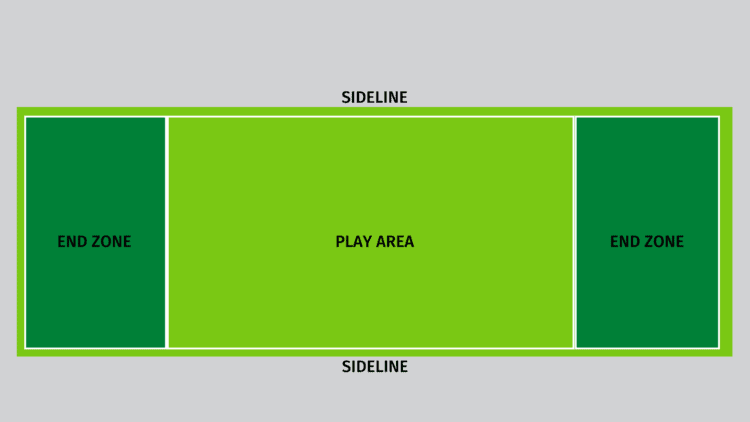
OBJECTIVE OF ULTIMATE FRISBEE: Score more points than the opposing team by passing the frisbee to a teammate in the end zone.
NUMBER OF PLAYERS: 14, 7 players on each team
MATERIALS: Frisbee disc
TYPE OF GAME: Sport
AUDIENCE: 8+
OVERVIEW OF ULTIMATE FRISBEE
Ultimate frisbee was developed in 1968 by a group of students at Columbia HS in Maplewood, New Jersey. This relatively new sport has been gaining popularity in the last few decades. Ultimate frisbee is a super fun sport to play and watch, and it is fairly easy to understand the rules.
SETUP

FIELD
An ultimate frisbee field is 40 yards wide and 120 yards long. There are 2 end zones on each end of the field that are 25 yards deep and 40 yards wide. Sidelines mark the out-of-bounds zone.
PLAYERS
There are 7 players on each team that stand in various formations. For most of the game, the 7 players run around the field and try and open up opportunities to catch the frisbee and score.
There are usually 3 offensive players that stay near the endzone, 2 mid-field players that defend and create scoring opportunities, and 2 defenders that stick to the back of the field to block passes and prevent the other team from scoring.
GAMEPLAY

The game starts with a coin toss or a game of rock paper scissors to determine which team gets possession of the disc first. The other team then throws the disc across the field to the team that wins the coin toss.
Ultimate frisbee is divided into two 20-minute halves separated by a 5-minute break.
PASSING
If you catch the frisbee at any point, you are not allowed to run with it. If you catch the disc, you then have 10 seconds to pass it to a teammate. If a player with the frisbee fails to pass the frisbee within 10 seconds, the opposing team gains possession. Defending players will count down from 10 seconds as soon as one player catches the frisbee. You can pivot and spin around, but one foot must stay on the ground at all times while the disc is in your hand. The frisbee can be passed ahead or behind.
TURNOVER
A turnover occurs when a pass is incomplete. If the frisbee is passed to a teammate and they fail to catch it, the other team gets automatic possession of the disc. A turnover can also occur if a player from another team intercepts the frisbee while it is in the air.
DEFENDING
Defenders are allowed to stand 3 yards from the player with the frisbee and cannot touch the player. Defenders are not allowed to touch the frisbee before it leaves a player’s hand, and they cannot prevent a player from catching the disc. While a defensive player can intercept the frisbee, they cannot impede a player who is about to catch it.
A defensive player who’s blocking a player with the frisbee must count down from 10, also called a stall count.
OUT OF BOUNDS
If one team throws the frisbee out of bounds or catches the frisbee out of bounds, possession is given to the other team. A player from the opposing team then passes the frisbee back into play from the point on the sideline where it went out of bounds.
SCORING
To score points, a player must catch the frisbee in the opposing team’s end zone. Each goal is worth 1 point. Once a team scores a point, they throw the frisbee across the field to the other team, much like they do in the beginning of the game.
FOULS
There are a few rules in ultimate frisbee that, if broken, will result in a foul:
- Traveling: Traveling is when a player runs with the frisbee. If a pass is completed while traveling, the game stops and the last pass does not count. The disc is then returned to the player who committed the foul who will then attempt the pass again, and the stall count will start from 1 number less than the last number in the count. For example, if the stall count was at 7 when the player made the pass, it will start at 6. No penalty is necessary if the pass is incomplete.
- Stripping: Stripping is when a defensive player touches or grabs the frisbee while still in a player’s hand. If this occurs, the player gets to attempt the pass again.
- Excessive roughness: Excessive roughness occurs when a player purposefully makes contact with another player. This will result in the player getting a warning or being ejected from the game, and the player that was fouled will gain possession of the frisbee.
- Pass interference: Pass interference happens when a defensive player blocks an offensive player from catching the disc. This results in the player that was fouled gaining possession of the frisbee at the point of the infraction.
END OF GAME
At the end of the second quarter, the team with the highest score wins! If the game is tied after the second quarter, the teams begin a sudden death period and continue playing until one team scores a point.
- 20+ FREE PRINTABLE BABY SHOWER GAMES - April 16, 2024
- 20+ College Party Games for the Best Night Ever! - April 2, 2024
- 31 BEST MOVIE DRINKING GAMES - March 14, 2024